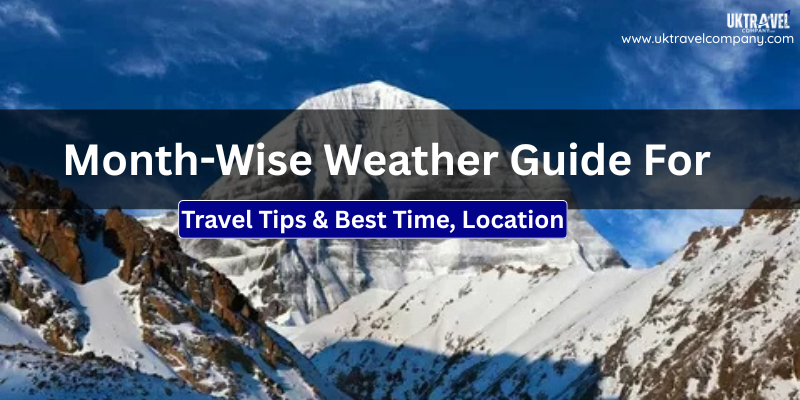Table of Contents
Introduction
Adi Kailash, also known as Chhota Kailash, and Om Parvat are two of the most sacred and picturesque Himalayan peaks in Uttarakhand’s Kumaon region. Known for their spiritual significance and breathtaking beauty, these destinations attract pilgrims, trekkers, and nature enthusiasts from around the world. Due to their high altitude (over 6,000 meters) and remote location near the Indo-Nepal-Tibet border, weather plays a crucial role in planning a successful journey. Understanding the month-wise weather conditions helps travelers decide the best time for darshan and safe trekking.
Geography and Climate Overview
- Location: Kumaon Himalayas, Uttarakhand
- Altitude: Around 6,191 meters
- Climate Pattern: Typical high-altitude Himalayan climate with long, harsh winters, short summers, and a monsoon period.
- Impact on Yatra: Accessibility is entirely dependent on weather conditions, as snow, rainfall, and landslides frequently block routes.
Month-Wise Weather Guide For Visiting Adi Kailash and Om Parvat
| January – February | Temperature: -15°C to -5°C Conditions: Heavy snowfall blankets the region, making roads and passes impassable. Risks: Avalanches, extreme cold, frostbite, and road closures. Suitability: Not recommended for pilgrims or trekkers. |
| March – April | Temperature: -5°C to 10°C Conditions: Snow begins to melt slowly, but many routes remain blocked. Highlights: Stunning snow-clad views, blooming alpine flora. Suitability: Limited trekking possible, but yatra season not yet open. |
| May – June | Temperature: 5°C to 15°C Conditions: Snow clears, roads open, and trekking becomes manageable. Highlights: Official yatra season begins, clear skies provide excellent visibility of both Adi Kailash and Om Parvat. Suitability: One of the best times for pilgrimage and trekking. |
| July – August | Temperature: 10°C to 18°C Conditions: Heavy rainfall causes landslides, floods, and slippery trails. Risks: Poor visibility, blocked routes, and potential cloudbursts. Suitability: Yatra not recommended during these months. |
| September – October | Temperature: 0°C to 12°C Conditions: Crystal-clear skies, fresh greenery, and snow-draped peaks. Highlights: It is easy to see Om Parvat’s natural snow creation, which resembles the holy “Om” symbol. Suitability: Peak pilgrimage season, ideal for both yatris and trekkers. |
| November – December | Temperature: -10°C to 5°C Conditions: Early snowfall begins, roads start closing again. Highlights: Pristine winter landscapes, but harsh conditions at night. Suitability: Limited access, yatra usually ends by early November. |

Best Time to Visit Adi Kailash and Om Parvat
May through June and September through October are the best times of year to vist Adi Kailash and Om Parvat. During these months, the weather is relatively stable, roads are accessible, and visibility is excellent for darshan. These periods of
fer a balance of safe travel conditions and breathtaking natural beauty.
Explore Our Adi Kailash Om Parvat Yatra Packages
Travel Tips for Different Seasons
- Clothing: Carry layered woolens, waterproof jackets, gloves, and sturdy trekking shoes, even in summer.
- Health Precautions: Acclimatize properly to avoid altitude sickness. Carry basic medicines and stay hydrated.
- Avoid Monsoon: Travel during July–August is unsafe due to landslides and poor road conditions.
- Permits: Ensure you have the required Inner Line Permit (ILP) before planning your yatra.
- Fitness: Prepare with light trekking and stamina-building exercises in advance.
Also Read– Adi Kailash best time to visit
FAQs about Weather in Adi Kailash and Om Parvat
Which month is best for Om Parvat darshan?
September–October is ideal, as the snow clearly displays the natural ‘Om’ symbol.
Is winter travel possible?
No, heavy snowfall and extreme cold make winter unsafe for yatris.
Can senior citizens travel safely?
Yes, during May–June and September–October with proper preparation and medical fitness.
What should I pack for May–June trips?
Warm clothes, trekking gear, medicines, and sun protection.
How is the weather in September–October?
Cool and pleasant, with daytime temperatures around 10°C and clear skies.
Conclusion
Weather is the most crucial factor in planning your Adi Kailash and Om Parvat Yatra. Harsh winters and unpredictable monsoons make large parts of the year unsafe for travel. The best time to visit is May–June and September–October, when the routes are open, the skies are clear, and the divine peaks are visible in all their glory. With the right preparation, permits, and timing, your journey to these sacred Himalayan destinations will be both safe and spiritually rewarding.



